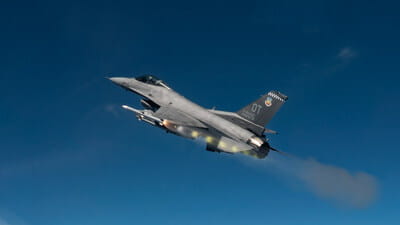RTX Business Collins Aerospace Completes MS-110 Flight Integration on Fighters
Collins Aerospace has announced the completion of flight testing for the MS-110 Multispectral Airborne Reconnaissance System to enter operational service.
Following the first flight in July 2022 on an F-16 for an undisclosed international customer, Collins executed a number of extensive flight tests and related ground activities to confirm that the system’s wide area, long range sensor suite is now ready for deployment.
The company is in the process of delivering a total of 16 sensors to international fast-jet operators and is in various stages of contractual activities for another 13 pods for three additional customers.
The advanced MS-110 builds on the success of the widely deployed DB-110 with which it shares a common support and imagery exploitation infrastructure, it said in a July 14 statement. Existing DB-110 operators have the option of upgrading their pods to the MS-110 configuration at their own maintenance facilities, limiting cost and operational downtime for this critical reconnaissance resource. The multispectral features of the MS-110 improves intelligence analysts’ ability to extract vital information from a wide variety of target sets.
“With MS-110 development and integration completed, the critical intelligence made available by the system can be rapidly rolled out to support multi-domain efforts,” said Andy Hunter, director and general manager, Intelligent Sensing for Collins Aerospace. “The extension and expansion of an Indefinite Delivery, Indefinite Quantity contract with the US Air Force Foreign Military Sales organisation will be a major factor in accelerating production and improving system affordability.”
Collins Aerospace airborne reconnaissance systems have been fielded and operational on tactical fast jet platforms such as the F-15 and F-16 as well as special mission ISR business jets. The system is also compatible with MALE UAVs such as the MQ-9. The MS-110 sensor leverages Collins Aerospace’s proven multi-spectral imaging (MSI) expertise from SYERS-2C flown on the U-2.
This follows a July 10 report that the US Air Force and Raytheon, an RTX business, have successfully completed all developmental and operational testing of the AIM-120D-3, which concluded with an F-16 live-fire of the missile with production hardware and software.
“We are ramping AMRAAM production to a greater rate than ever before in the history of this programme,” said Paul Ferraro, president of Air Power at Raytheon. “With significantly increased functionality, performance and producibility, and the completion of the flight test programme, we are ensuring warfighters can count on having the fifth generation of AMRAAM – and enough of them – in their arsenal.”
The AIM-120D-3 is the most advanced variant of the AMRAAM missile developed under the Form, Fit, Function Refresh (F3R) program, which upgraded circuit cards in the guidance section of the missile and allows for continuous agile software improvements. The latest AMRAAM is capable of countering peer threats.
Developmental and operational test of the AIM-120D-3 included captive carry and live-fires from both US Navy and US Air Force fourth and fifth generation platforms. The production ramp increases follow recent contracts, such as a $1.5 billion awarded in June 2023 and $972 million awarded in Sept 2022. – ca/adj/mgm (Pix: USAF)


